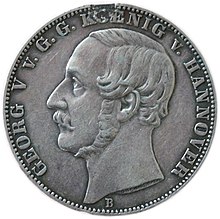Royal coin on the stone gate
The Königliche Münze am Steintor , also called the Königliche Münze an der Langen Laube in Hanover , was a villa built at the time of the Kingdom of Hanover , in which coins and medals were produced from the middle of the 19th century . The location was the site at the Steintor between the street Lange Laube and Goethestrasse , today's Münzstrasse .
history

Postcard (around 1900) after a lithograph
In 1817, the miner captain and later cabinet minister Franz von Meding acquired a piece of land called "Vorort 1". It was opposite the building of the former gun - foundry after the wars of liberation 1813 after Stade had been moved and their building for future artillery barracks at the stone gate of the former King's German Legion to build a now Royal Hanoverian army could be converted. Immediately between the former "piece foundry" and the so-called "von Medingschen possessions" at the address at that time Lange Laube 27 (later: house number 28 ) was a small guard house for the gate guard with two larger stone gate posts in front of it, which lasted until 1820 in the evening were still closed with lattice gates.
Here, in the von Medingschen Garten at the beginning of Georgstrasse , Franz von Meding had his own residential building built by the architect Georg Ludwig Friedrich Laves in the classicism style by 1819 .

A good three decades later, after the cabinet minister von Meding died in 1851, the royal state government bought the villa and the property from the heirs in order to set up a new Hanover mint there. In the meantime, the mint building built on Mühlenplatz at the time of the electorate around 1750 had become too narrow and no longer corresponded to the latest technical standards, especially after the Clausthal mint was merged with the Hanoverian mint in 1848 . The von Medingsche house at the Steintor became the new seat of the mint administration, with an official apartment for the royal mint master on the first floor. For the actual production of coins, another two-wing building was built in the garden of the villa according to the technical requirements.
In the Royal Mint at the Steintor, the medalist Friedrich Brehmer cut and minted his high-quality coins and medals, in collaboration with the royal mint master Theodor Wilhelm Brüel .
Even after the battle of Langensalza and the annexation of the State of Hanover by the Kingdom of Prussia , the now Royal Prussian Mint continued to work here until 1878. Then the mint was closed, the buildings demolished and a street built across the property, which was named Münzstraße in memory of 1879 .
literature
- Johannes Kretzschmar : The royal mint in Hanover . In: Journal of the Historical Association for Lower Saxony 1902, pp. 4–63, especially pp. 39–42 ( digitized version ).
Individual evidence
- ↑ a b c Ludwig Hoerner : Before the stone gate. In: Hanover in early photographs. 1848-1910 . Schirmer-Mosel, Munich 1979, ISBN 3-921375-44-4 , p. 192f.
- ^ Franz Rudolf Zankl (ed.): List of architects, compiled with the collaboration of Helmut Zimmermann , in this: Hanover. From the old train station to the new town hall. Pictorial documents on urban development in the second half of the 19th century , exhibition guide of the Historisches Museum am Hohen Ufer, Hanover, 1975, p. 42f.
- ↑ a b c d Klaus Mlynek : Münzwesen. In: Klaus Mlynek, Waldemar R. Röhrbein (eds.) U. a .: City Lexicon Hanover . From the beginning to the present. Schlütersche, Hannover 2009, ISBN 978-3-89993-662-9 , pp. 454f.
- ^ Helmut Zimmermann : Münzstrasse. In: The street names of the state capital Hanover , Verlag Hahnsche Buchhandlung, Hanover 1992, ISBN 3-7752-6120-6 , p. 178
- ↑ a b c d e Franz Rudolf Zankl : The coin building on the Long Laube. Photography. Around 1870. In: Hannover Archive , p. 87.
- ^ A b Franz Rudolf Zankl: The artillery barracks at the Steintor. Colored lithograph by Wilhelm Kretschmer. Around 1860. In: Hannover Archive , p. 92.
- ^ A b Bernhard Dörries, Helmut Plath : The stone gate. In: Alt-Hannover 1600 - 1900 / The history of a city in contemporary images from 1600 - 1900 , ed. on behalf of the city of Hanover and annual gift 1951 from the Kunstverein Hanover, Munich: F. Bruckmann, p. 56
- ↑ Journal of the Historical Association for Lower Saxony 1902, p. 28 et al .; partly online via Google books
Coordinates: 52 ° 22 '32.3 " N , 9 ° 43' 53.9" E